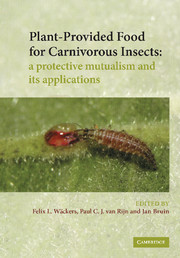Foreword by Peter W. Price
Published online by Cambridge University Press: 15 December 2009
Summary
Untangling Charles Darwin's “tangled bank” has motivated ecologists for well over a century. While Darwin could contemplate the many species and complex interactions of plants and animals along a roadside bank, he could hardly imagine the true dimensions of the intricacies in nature. Tangled interactions were soon perceived as more organized communities: the Biozönose of Karl Möbius in 1877 and the microcosm of Stephen Forbes in 1887. Food webs were gradually unraveled. An early example involved the cotton plant and the boll weevil complex, by Pierce, Cushman and Hood in 1912. Already, the staggering richness of trophic interrelationships was revealed, with over 300 species noted in the food web. These authors also documented the impact of cotton varieties on the attack on weevil larvae by parasitoids: an early example of three-trophic-level interactions.
An important next development was the dawn of chemical ecology which documented the ubiquity of multitrophic interactions. The aromas emanating from both plants and their herbivores were diagnosed as cues for higher trophic levels: phytochemicals could attract or repel herbivores and their natural enemies. But the field emphasized more the roles of plants and herbivores in influencing carnivores, and less the general ecology of the natural enemies themselves.
This book now remedies the former bias in the literature by placing natural enemies at center stage, and asking what the plant contributes to the intrinsic needs of the natural enemies: their full requirements of food, a place to live, and all their relationships with other species.
- Type
- Chapter
- Information
- Plant-Provided Food for Carnivorous InsectsA Protective Mutualism and its Applications, pp. xi - xiiPublisher: Cambridge University PressPrint publication year: 2005

